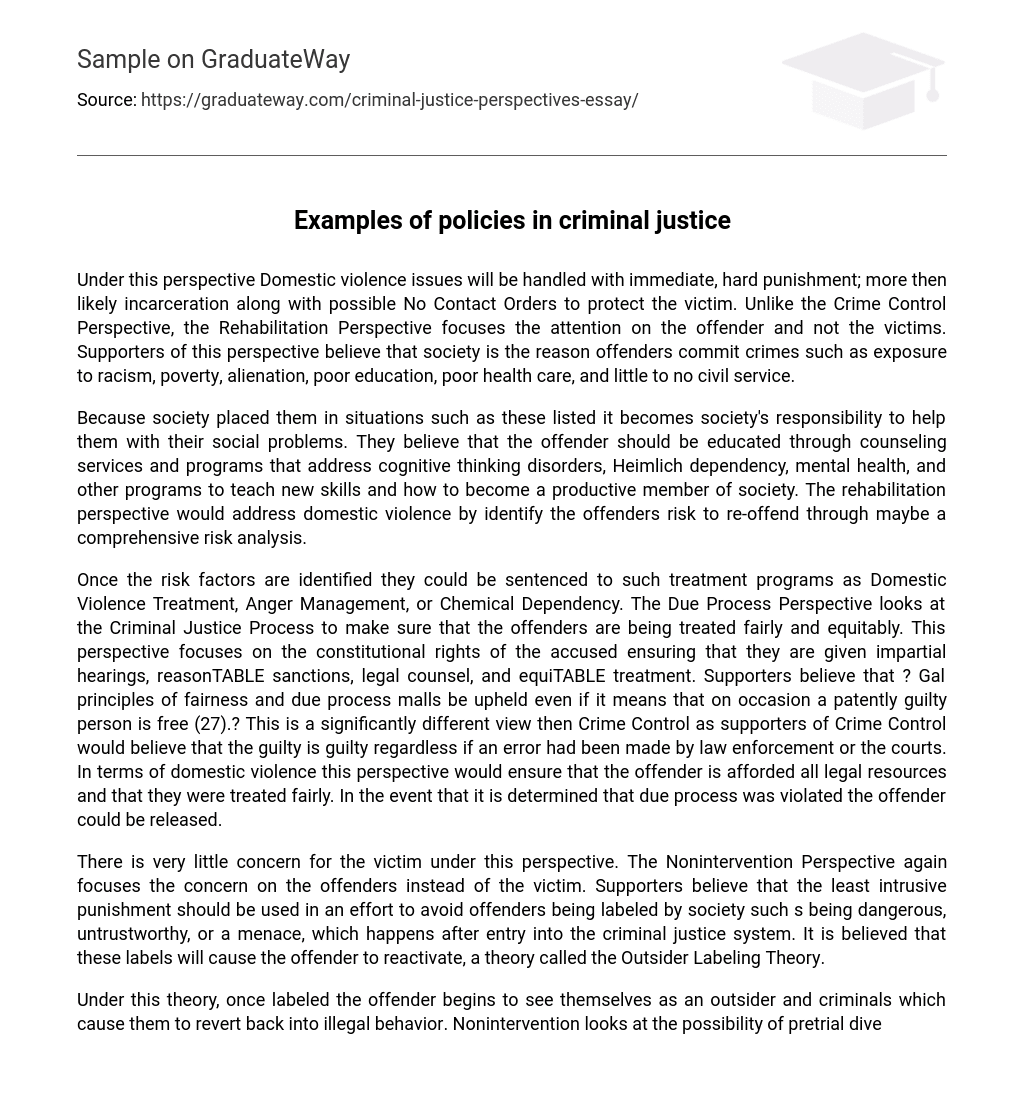Under this perspective Domestic violence issues will be handled with immediate, hard punishment; more then likely incarceration along with possible No Contact Orders to protect the victim. Unlike the Crime Control Perspective, the Rehabilitation Perspective focuses the attention on the offender and not the victims. Supporters of this perspective believe that society is the reason offenders commit crimes such as exposure to racism, poverty, alienation, poor education, poor health care, and little to no civil service.
Because society placed them in situations such as these listed it becomes society’s responsibility to help them with their social problems. They believe that the offender should be educated through counseling services and programs that address cognitive thinking disorders, Heimlich dependency, mental health, and other programs to teach new skills and how to become a productive member of society. The rehabilitation perspective would address domestic violence by identify the offenders risk to re-offend through maybe a comprehensive risk analysis.
Once the risk factors are identified they could be sentenced to such treatment programs as Domestic Violence Treatment, Anger Management, or Chemical Dependency. The Due Process Perspective looks at the Criminal Justice Process to make sure that the offenders are being treated fairly and equitably. This perspective focuses on the constitutional rights of the accused ensuring that they are given impartial hearings, reasonTABLE sanctions, legal counsel, and equiTABLE treatment. Supporters believe that ? Gal principles of fairness and due process malls be upheld even if it means that on occasion a patently guilty person is free (27).? This is a significantly different view then Crime Control as supporters of Crime Control would believe that the guilty is guilty regardless if an error had been made by law enforcement or the courts. In terms of domestic violence this perspective would ensure that the offender is afforded all legal resources and that they were treated fairly. In the event that it is determined that due process was violated the offender could be released.
There is very little concern for the victim under this perspective. The Nonintervention Perspective again focuses the concern on the offenders instead of the victim. Supporters believe that the least intrusive punishment should be used in an effort to avoid offenders being labeled by society such s being dangerous, untrustworthy, or a menace, which happens after entry into the criminal justice system. It is believed that these labels will cause the offender to reactivate, a theory called the Outsider Labeling Theory.
Under this theory, once labeled the offender begins to see themselves as an outsider and criminals which cause them to revert back into illegal behavior. Nonintervention looks at the possibility of pretrial diversion for first time offenders. Similar to the Rehabilitation, pre-trial diversion is community based treatment programs. They also support decentralization and demonstrativeness’s of non violent offenses. A domestic violence offense would be handled at the lowest degree possible, depending on the severity of the offense, to avoid any possibly labeling, such as ? Fife beater? Or ? Violent?. First time offenders maybe sentenced to treatment as a way of avoiding prison which would avoid the possibility of being labeled and a repeat offender. With the Justice Perspective supporters believe that there should be no difference between the offenders and that the law should kick at the crime itself and not what they have done in the past. Certain laws have been put into place such as truth in sentencing laws which ensure that offenders serve the majority part of their sentence in prison.
There are also mandatory minimum sentences based of the offense which indicates that an offender cannot be sentenced to less time then what the Mandatory Minimum sentence is for a particular crime. Domestic violence offenders would be sentenced based on the mandatory minimum range for that offense and all offenders would be sentenced in that range with similar domestic violence offenses. What sentence they got would depend on the nature of the crimes and not on his history or social problems such as the Rehabilitation Theory.
The last of the criminal justice perspectives is Restorative Justice. This perspective looks at restoring the community by readdressing the damage that was inflicted by the crime. This perspective is focused on the victim and peaceful resolutions. The offender is forced to accept responsibility for their acts and confronted by the damage they did to the victims by paying restitution, mediation with the victims such as victim impact panels, and paying there debt to the community by way of serving time on parole or community service.
This allows them to reintegrate back into the community. Unlike the Crime Control Perspective, giving jail time to non-violent offenders makes little sense if an alternative would be availTABLE to make restitution to the victim and the community. This perspective also contradicts the Justice Perspective of abolishing parole. This perspective might look at domestic violence with the possibility of having the offender and their families participate in family mediation programs.
Depending on whether the offense was violent, they may be sentenced to Community Custody or parole instead of jail time and may be required to do Community Service hours. After consideration of each of these perspectives, I do not feel that any one of them is the most effective means of controlling crime and recidivism rates when it comes to domestic violence or any other offense. I think that the key is finding the balance between the perspectives and utilizing each one to make the Criminal Justice System as effective as possible in controlling the crime rate in the United States.





